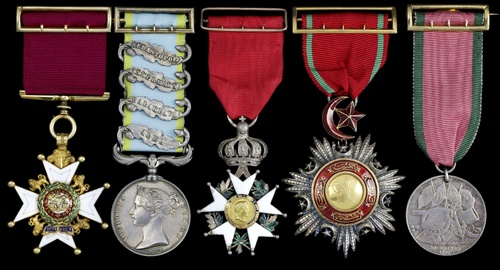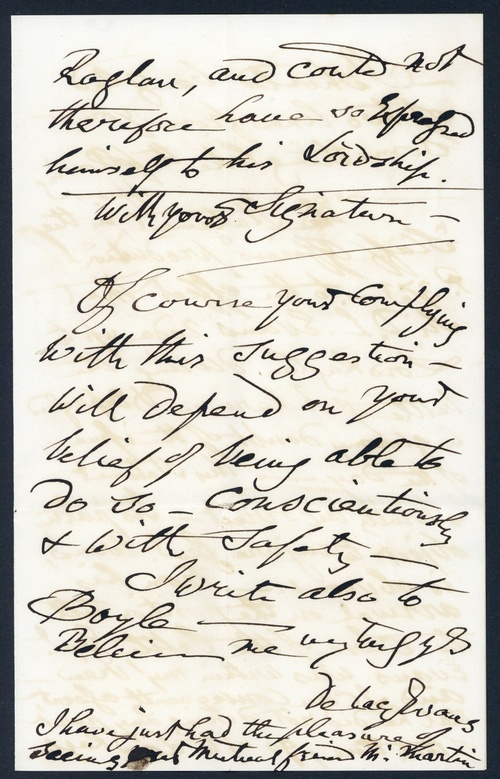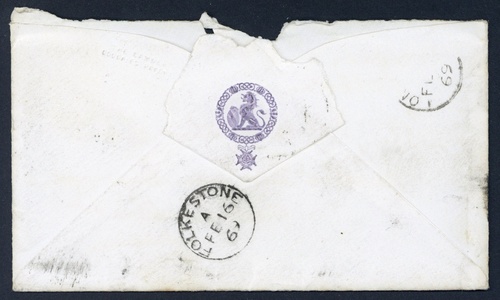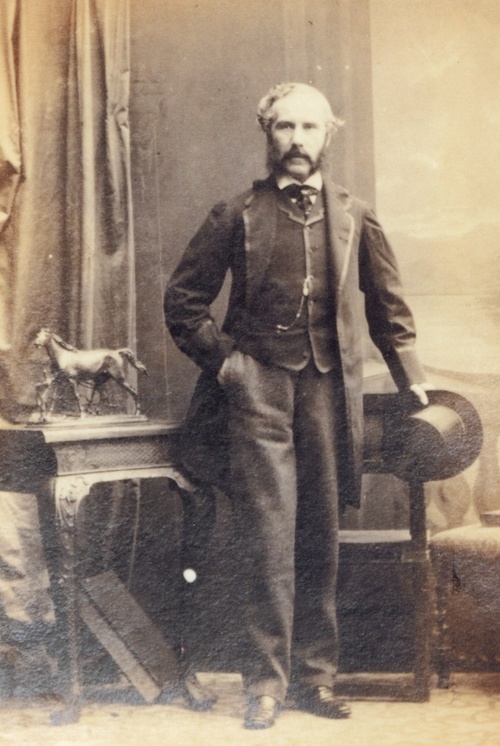Auction: 19001 - Orders, Decorations and Medals
Lot: 375
(x) A poignant 'Capture of the Quarries' group of five to Lieutenant-General James Wells Armstrong, C.B., late 49th Regiment, who served as Brigade-Major of Adams's Brigade, 2nd Division; at Inkermann on 5 November, Armstrong took Adams's request for support to the Duke of Cambridge, who then advanced with the Guards Brigade.
Armstrong is best remembered for his gallant part in capturing The Quarries, a key Russian earthwork guarding Sebastopol. He led the 'left attack' in the daring assault of 7 June 1855, and continued to give orders despite a severe wound from grapeshot; a subsequent injury from a fougasse led to his early demise.
The Most Honourable Order of the Bath, C.B. (Military) Companion's breast Badge, gold (22 carat) and enamel, hallmarks for William Neal, London 1850, fitted with narrow swivel-ring suspension and gold riband buckle; Crimea 1854-56, 4 clasps, Alma, Balaklava, Inkermann, Sebastopol (Mar. of Brigade, I. W. Armstrong, 49th Regt.), contemporarily engraved by Hunt & Roskell; France, Second Empire, Legion of Honour, 5th Class breast Badge, silver, gold centre and enamel; Turkey, Sultanate, Order of the Medjidie, 4th Class breast Badge, silver, gold centre and enamel; Turkish Crimea, Sardinian issue, replacement ball and ring suspension, all fitted with gold top riband buckles, very fine, the Crimea Medal extremely fine (5)
C.B. London Gazette 2 January 1857.
Legion of Honour London Gazette 4 August 1856.
James Wells Armstrong was a son of James Armstrong, of the Bengal Civil Service, and a nephew of Lieutenant-Colonel Thomas Armstrong. He was first commissioned as an Ensign with the 49th (Princess Charlotte of Wales's) Regiment of Foot on 18 August 1843. Promoted to Lieutenant on 29 November 1844, he was appointed Adjutant of the Regiment on 25 August 1846. On 20 January 1851 he rose to the rank of Captain. During the Crimean War Armstrong served as Brigade-Major of Adams's Brigade, 2nd Division. He was present at Alma, Balaklava, Inkermann, and the Siege of Sebastopol.
Inkermann
At 'Little Inkermann' on 26 October, Armstrong led two 2nd Division Companies to reinforce the hard-pressed picquets of the 49th Foot. His intervention came when the Russian attack was at its fiercest, and may have saved the British left flank (Kinglake 1901, Vol. 5, 376).
Adams's Brigade fought with unsurpassed gallantry during the infamous 'Soldier's Battle' on 5 November. At about 7 a.m., Adams held the Sandbag Battery with no more than 700 men against a force of 10,000 Russian infantry. He ordered his Brigade-Major, Armstrong, to ride back and learn if any reinforcements were available. Armstrong found the Duke of Cambridge approaching with two battalions of the Guards. He persuaded the Duke to march to the scene of heaviest fighting, the Sandbag Battery. His intervention thus shaped the subsequent course of the battle, for the Sandbag Battery - nicknamed 'The Abattoir' by French observers - was bitterly contested throughout the day.
Armstrong then hurried back to Adams with the jubilant news that the Guards were coming - this lifted the men's morale considerably. Later in the battle, the French 6th Line Regiment arrived on Home Ridge to offer support. Seeing the intensity of the fighting, this regiment suddenly halted and would advance no further. As furious British soldiers accused their allies of cowardice, Armstrong calmly rode up to the regiment and urged it in his best French to advance. He evoked the glories of their Napoleonic forebears, which seemed to inspire them (Mercer 1998, 120). At length the French drums sounded the 'pas de charge', and the 6th Line entered the fray. Armstrong's horse was then shot from under him. In recognition of his services he was promoted to Brevet Major on 12 December 1854.
Sebastopol - The Quarries
Following the British narrow escape at Inkermann, it was decided that the French Army would take over the right flank of the siege lines, concentrating their efforts on the formidable Malakoff Redoubt. The British moved to a less exposed position facing another key Russian strongpoint, the Redan. Organising the town's defences was a German in Russian service, the brilliant General Eduard Todleben. From 19 April 1855, Todleben constructed a double belt of earthworks some 400 yards in advance of the Redan, stretching across the whole Woronzoff Ridge. He called them 'counter-approaches', their aim being to delay or repel any attempt on the Redan. The strongest part lay on the crest of small ridge, with patches of excavated ground clearly visible in its rear, hence its British nickname 'The Quarries'. In the ground directly in front, the Russians lay mines or fougasses with 35-pound powder charges.
On 7 June, Armstrong led 200 men of a picked 400-strong British force ordered to capture The Quarries. His men were carefully drawn from the 2nd Division, while the Light Division furnished the other 200 under Colonel Robert Campbell, 90th Foot. Lord Raglan decided that the attack should be directed solely against the flanks of the Russian strongpoint, where fougasses had not been laid. Without firing a shot, the two storming parties made for opposite ends of The Quarries, taking the Russians by surprise. Armstrong commanded the Left Column. The attack was a complete success, but just as his men gained their objective, Armstrong was severely wounded by grape-shot in the thigh.
Ignoring his injury, Armstrong continued to give orders, ensuring that the new position was properly consolidated. As his men pleaded to carry him to the rear, he forbade them, saying firmly: "No, no; lay me down at the bottom of the ditch; for we can't spare a man till we know whether the enemy will attempt a recapture" (Kinglake 1901, 118). His judgement proved correct, for the Russians launched six major counter-attacks that night, The Quarries changing hands four times.
When eventually he was carried off the field, his stretcher bearers trod on a fougasse, setting off a violent explosion which gave him (by concussion) a permanent injury to the heart. This led to his premature death several years later. He was promoted to Lieutenant-Colonel on 17 July, receiving the 5th Class of the Legion of Honour and of the Medjidie.
Armstrong commanded No. 4 Depot Battalion from October 1855 to 1860, when he was placed on Half Pay. He then served at Horse Guards as Inspector General of Auxiliary Forces, a position he held until his death. Promoted to Lieutenant-General on 1 October 1877, he died in London on 12 April 1880.
Sold with an historically important archive, including:
(i)
A large collection of over forty handwritten letters, many in stamped envelopes, addressed to Armstrong and various recipients, including one written by General Sir John Pennefather G.C.B., congratulating Armstrong on his promotions.
(ii)
An extensive folder of copied research, with London Gazette entries.
Reference works:
Kinglake, A. W., The Invasion of the Crimea, Vols. V & IX (Edinburgh, 1901).
Mercer, P., 'Give them a Volley and Charge!' The Battle of Inkermann, 1854 (Staplehurst, 1998).
Subject to 5% tax on Hammer Price in addition to 20% VAT on Buyer’s Premium. For more information please view Terms and Conditions for Buyers.
Sold for
£3,500













